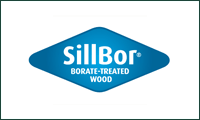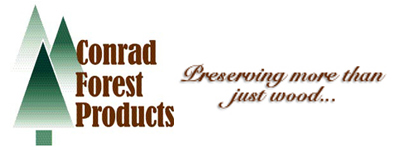Sillbor®/FrameGuard® (Disodium Octaborate Tetrahydrate)

SillBor® wood has been pressure-impregnated with a borate (SBX) preservative which makes the wood resistant to attack by insects and fungal decay. It is suitable for interior and weather-shielded applications.
This specification describes the requirements for the preservation of certain softwood joinery and wooden building components by means of an aqueous solution of Sillbor®/FrameGuard® (disodium octaborate tetrahydrate) applied by pressure process. The joinery and components for which this preservation treatment is intended are those made from wood which is to be protected by a roof and/or sealed by application of a waterproof coating such as an oil-based paint. Sillbor® / FrameGuard® treated in accordance with this specification is not suitable for use where there is direct contact with the ground or where continuous wet conditions or continuous contact with water is involved.

It is well suited, therefore, for the protection of wood building materials where leaching is not a normal hazard except during the initial period of construction. It is also suitable for external joinery provided the joinery is primed before exposure, as the losses under paint are likely to be much lower than those from unpainted wood. External joinery made from pressure treated wood should be primed before leaving the workshop and, once on site, positioned and painted as soon as possible. Where borate-treated wood is used for purposes such as cladding or external woodwork, indications are that the treatment should remain effective provided the wood is kept well painted.
Borate-treated wood is not suitable for situations where there is a severe leaching hazard (e.g. ground contact or permanently wet conditions) as the preservative would ultimately be leached from the wood under these conditions. Thus it is not considered suitable for the long-term protection of wood that is to be used unprotected outdoors, such as fencing posts or poles; nor, obviously, could it be used for cooling tower wood.
USE OF PRESSURE-TREATED WOOD. Sillbor/FrameGuard borate pressure treated wood is suitable for most purposes in building construction work. Roof battens, purlins, trusses, wall plates, ceiling joists, floor beams and boarding, internal structural members and door frames, as well as painted external joinery are all examples where the treated wood could be used quire satisfactorily.
Wood that has been pressure treated with borate is only slightly more abrasive than untreated wood. Present indications with roof trusses are that metal plant fasteners can be used with the treated wood without any significant problems arising.
Laboratory tests have shown that the treatment has no significant effect on the strength of wood. Present indications with roof trusses are that metal plate fasteners can be used with the treated wood without any significant problems arising. Provided that the Sillbor/FrameGuardtreated wood is dried to a surface moisture content of 18% or below, there should be no adverse effect on painting. Oil based, alkyd based and emulsion (acrylic) primers have been used without any difficulties being recorded. If for any reason the wood becomes wetted under the paint film, adhesion may be impaired.
If it is properly dried to the appropriate moisture content and all surface deposits removed, Sillbor/FrameGuard borate-treated wood can be glued successfully with most normally assembly glues. Although there is some conflicting experimental evidence of the compatibility of borate-treated wood with glues of the phenol or resorcinol type, there is little evidence of failure in practice. One instance of glue-line failure has been reported and this was in the manufacture of laminated beams from the treated wood. However, it should be remembered that under these conditions the faces to be glued have a high loading of preservative and special care must be taken in preparing the surfaces and in selecting a suitable glue. In these circumstances, it is wise to confirm its compatibility with the glue manufacturer concerned.
Since penetration of Doug fir is generally very limited to outer shell it is unlikely that the borate will migrate enough to protect any cut ends. Thus the requirement... That said, for best protection for Douglas fir, it is good practice for all cut ends to be field treated with preservative.
RETENTION REQUIREMENTS OF THE AMERICAN WOOD-PRESERVERS' ASSOCIATION
| B203 (pcf) | DOT equivalent | Re-dried after treatment | Brand | Application |
|---|---|---|---|---|
| 0.17 | 0.25 | optional | Sillbor®/FrameGuard® | Not for use where Formosan termites are present |
| 0.28 | 0.42 | optional | Sillbor®/FrameGuard® | Warranted against Formosan termites |
| 0.28 | 0.42 | optional | Sillbor®/FrameGuard® Ali'i™ | Specifically for use in Hawaii |
CODE COMPLIANCE

Borate-treated wood is referenced in the following 2003 model codes.
- International Building Code:section 2308.1.8, preservative treated wood
- International Residential Code:section R319.1, protection against decay
- International Residential Code:section R320, protection against termites
